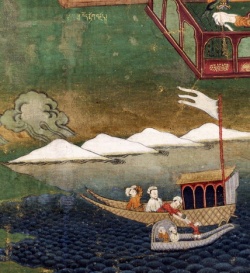First Council
First Council: 500 Arhats convened at Rajagrha by Venerable Mahakasyapa to codify the teachings of the Buddha immediately after the Buddha’s parinirvana. Also known as 500 Council, Theravada Council", The First Compilation, etc. The assembly of 500 leading Bhikhus gathered for 3 months after the Buddha's death to compile the Buddhist sutras. It was held at Cave of the Seven Leaves near Rajagaha.
In the assembly, Ananda recited the Sutta-pitaka, Upali recited the Rules of Disciplines of the Order, i.e., Vinaya-pitaka, and Kassapa recited the Abhidhamma. Thus, the Tripitaka was adopted as a unity of doctrines and opinions within the religious order, and also an orthodox teaching for the Buddhists to follow.
Both the Pali scriptures and the Mahayana scriptures did not appear until about 500 years after Buddha entered into Parinirvana. They appeared at about the same time. Prior to that, scriptures are only orally transmitted and it was not compiled in written forms. Or it could be written on things like leafs. People please correct me if I am wrong anywhere in this post.
Lotus sutra is not the first Mahayana sutra expounded by the Buddha, and so it is not that Mahayana practise originated from Lotus Sutra. The first Mahayana teachings was on Avatamsaka Sutra, and that sutra was expounded not to humans but to Bodhisattvas and other beings. It was expounded right after Shakyamuni Buddha attained enlightenment, and the teachings of Avatamsaka was so deep that only the Bodhisattvas could fully comprehend the teaching and its essence. It was only after Avatamsaka was taught that later the four noble truths was taught.
According to an explanation Shakyamuni Buddha taught his teachings in five periods (and lotus sutra was taught in the last period):
The Five Periods are:
1. The Avatamsaka Period (21 days after enlightenment)
After the enlightenment of Shakyamuni Buddha, he spoke the Avatamsaka Sutra for 21 days, but only the Bodhisattva heard it. Those Arhats and Bhiksus of the Small Vehicle did not even see him. So the period of speaking the Avatamsaka Sutra was for the teaching of great Bodhisattvas. The Sutra expounds the Wonderful Dharma of infinite realm of "One Trueness" in the Buddhalands.
2. The Agama Period (12 years during travelling in 16 countries) Agama, a Sanskrit word, means "incomparable Dharma", for none of the teachings of non-Buddhist religions can compare with it. So, the period of speaking the Agama Sutras was for the teaching of the Small Vehicle, and for those with the lowest root.
3. The Vaipulya Period (8 years thereafter) Vaipulya, a Sanskrit word, means "extensive". The Vaipulya teaching pervades the former Agama teaching and the following Prajna teaching. Both those of the Small Vehicle and those of the Great Vehicle can study the Sutras of this period.
4. The Prajna Period (22 years in preaching) The period of speaking the Sutras was for the beginners of the Great Vehicle. It is distinct and separate from the Vaipulya period and the Lotus-Nirvana Period. The teaching spoken in this period is basically collected in Mahaprajna Sutra.
5. The Dharma Flower - Nirvana Period (8 years before Nirvana) This is the ultimate teaching of the Buddha. The teachings of the previous four periods are provisional, manifesting for the sake of the real. The Lotus Sutra was spoken in this period, which opened the provisional and manifested the real.
see also; First Buddhist council
